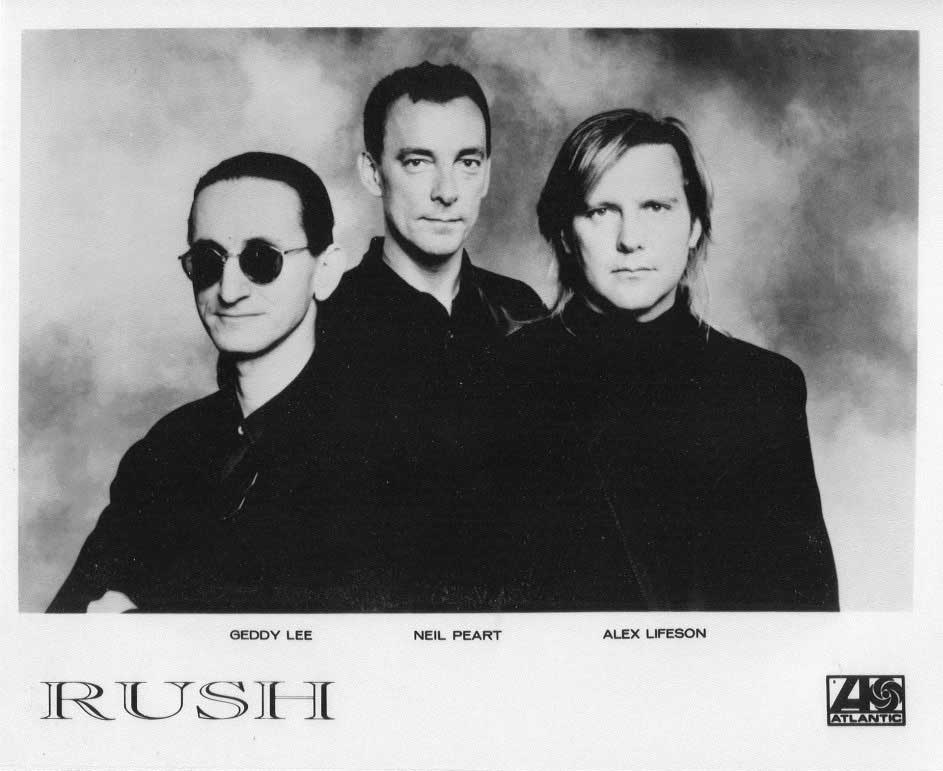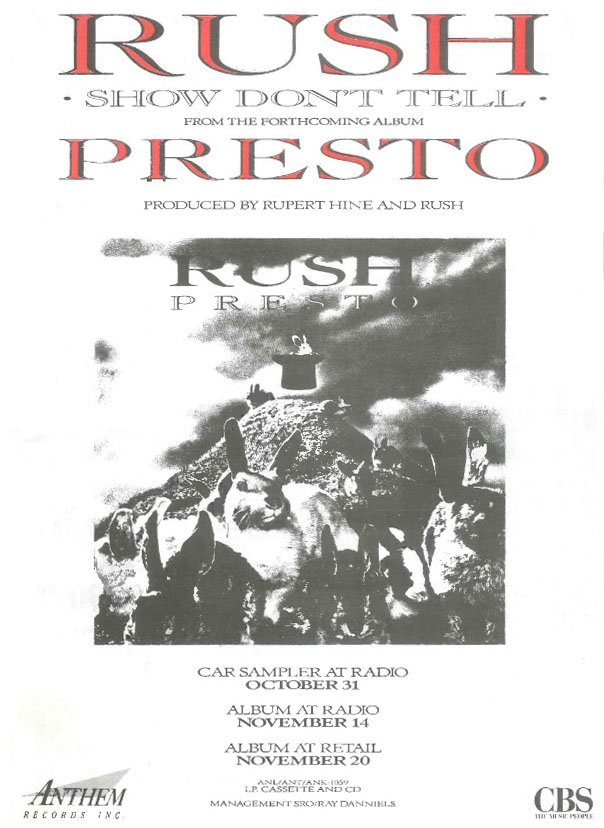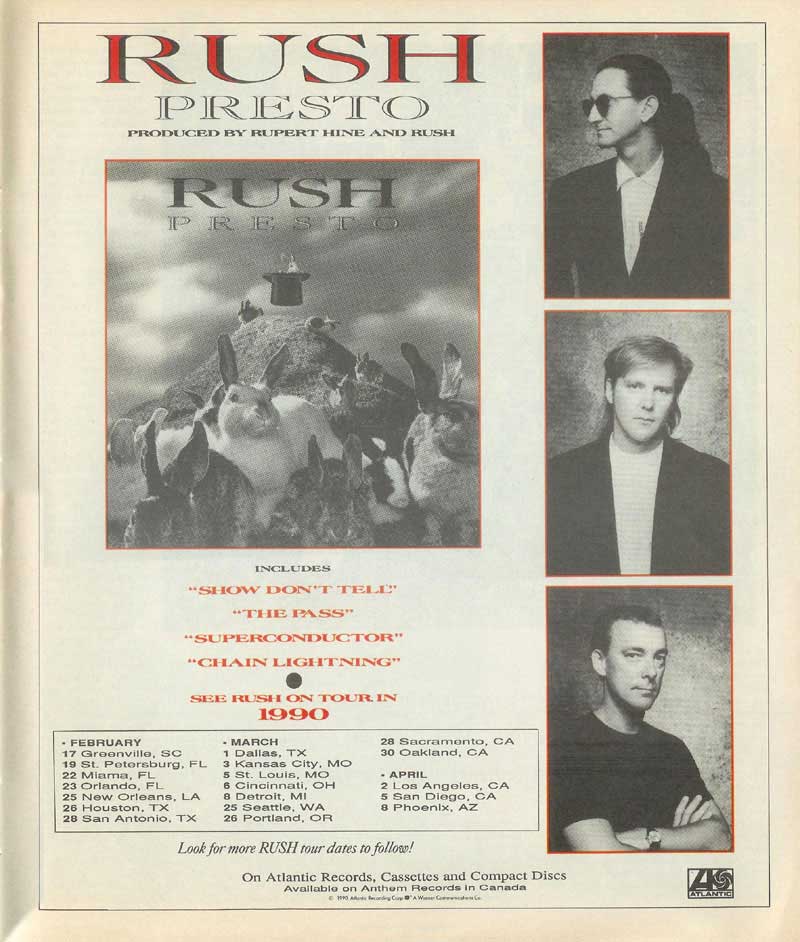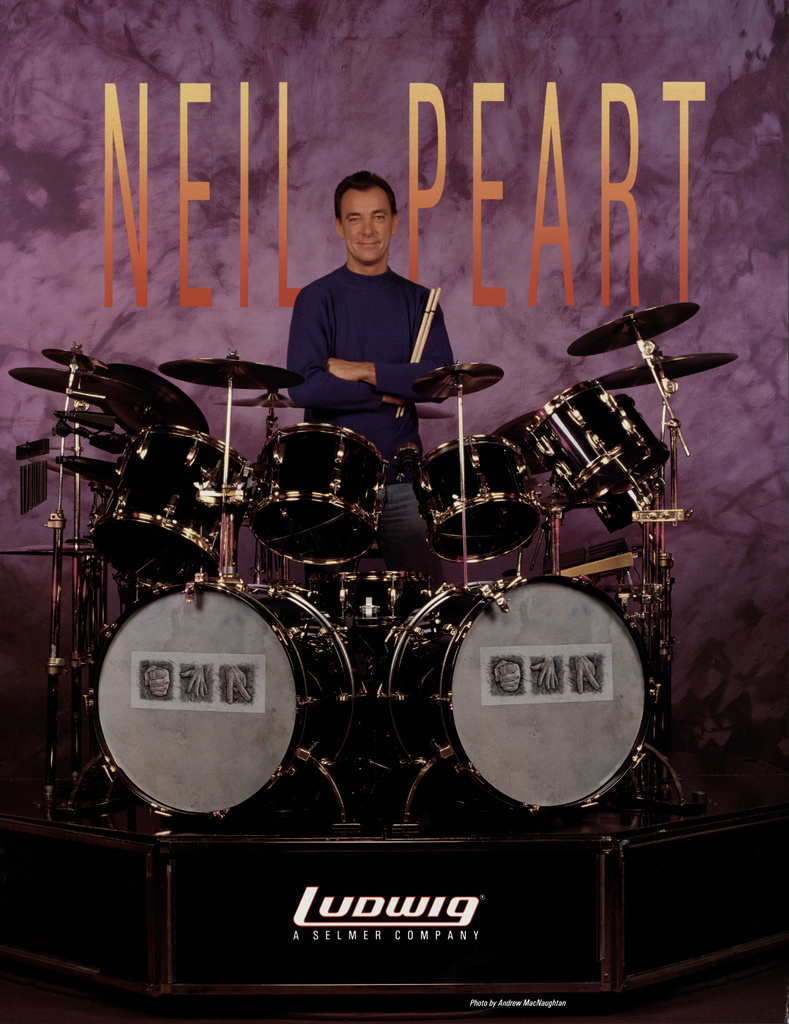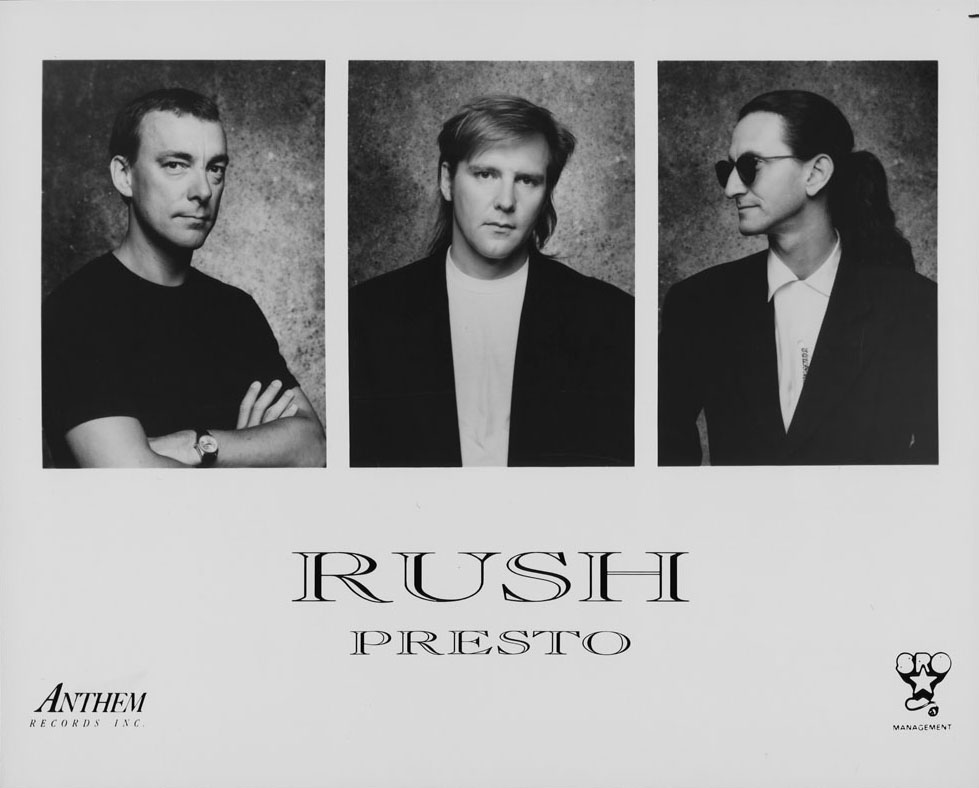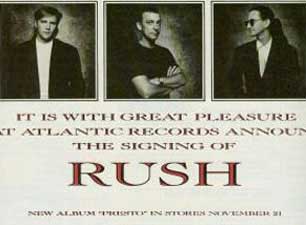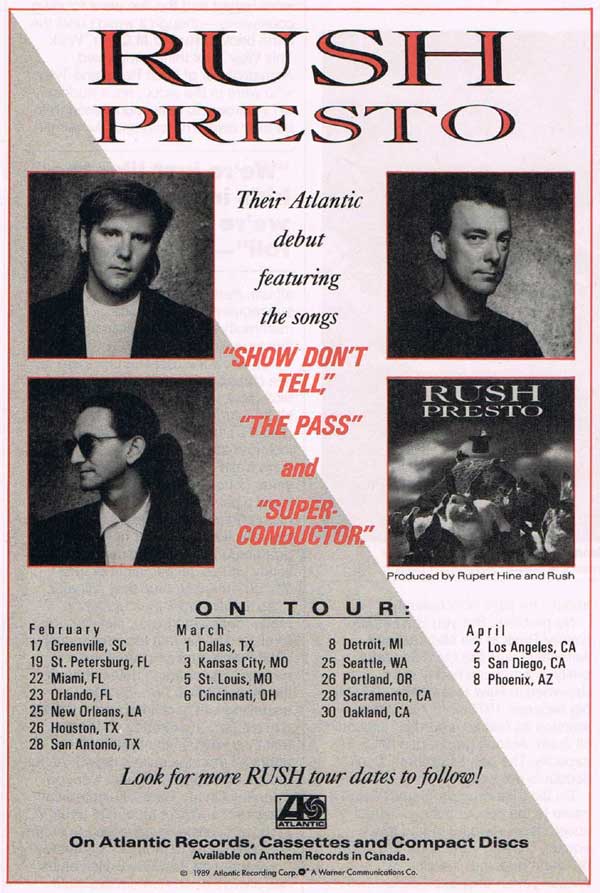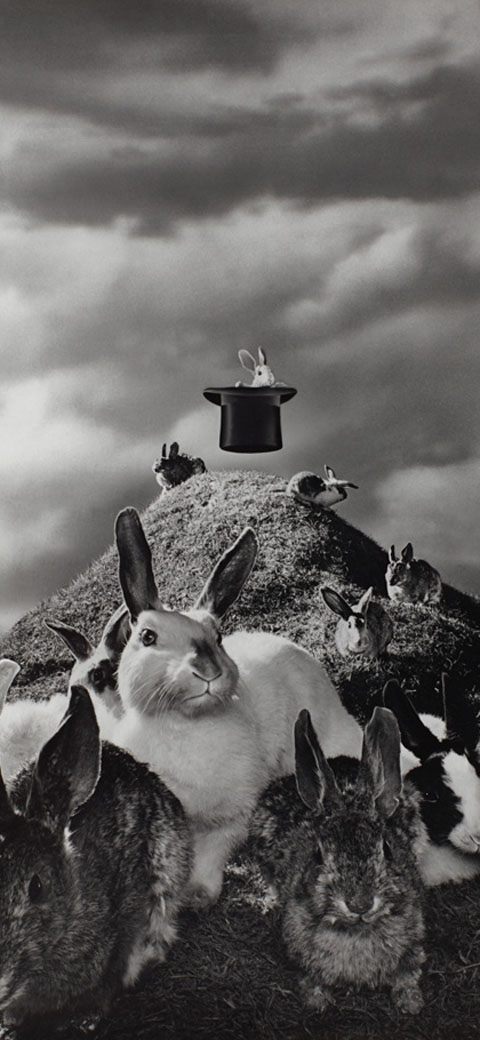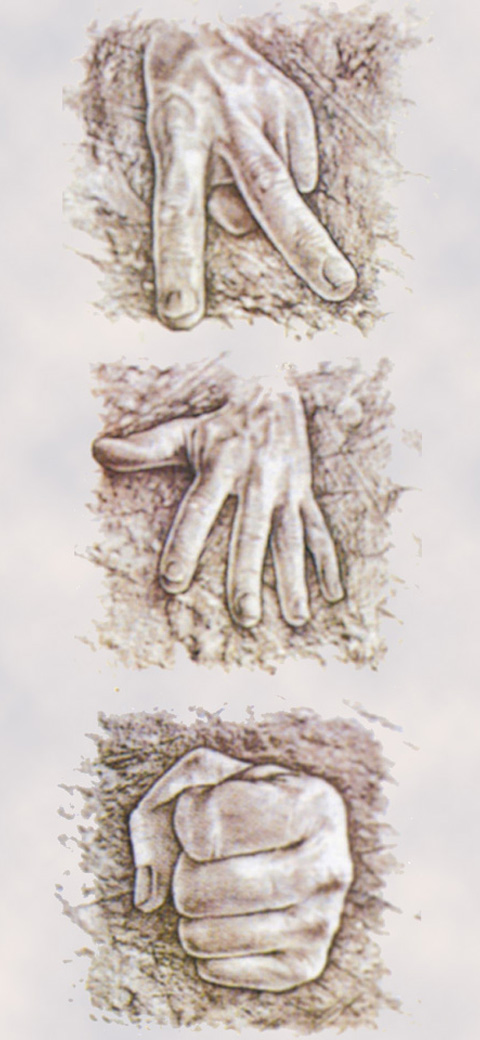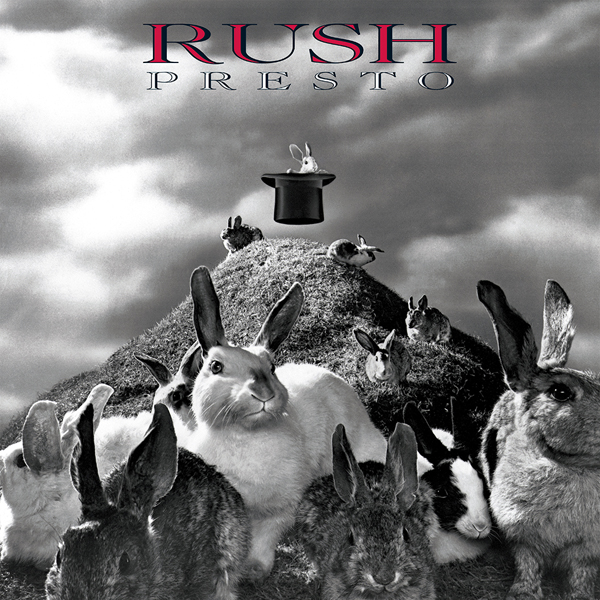
Show Don't Tell (5:01)
Chain Lightning (4:33)
The Pass (4:51)
War Paint (5:24)
Scars (4:07)
Presto (5:45)
Superconductor (4:47)
Anagram (For Mongo) (4:00)
Red Tide (4:29)
Hand Over Fist (4:11)
Available Light (5:03)
ALEX LIFESON
Electric and acoustic guitars
NEIL PEART
Drums and electronic percussion
GEDDY LEE
Bass guitar, vocals, synthesizers
Produced by Rupert Hine and Rush
Engineered by Stephen W. Tayler
Arrangements by Rush and Rupert Hine
Recorded June--August 1989
Le Studio, Morin Heights, assisted by Simon Pressey and Jacques Deveau
McClear Place, Toronto, assisted by Rick Andersen
Mixed September 1989 at Metropolis, London, assisted by Matt Howe
Additional keyboards by Rupert Hine and Jason Sniderman
Additional backround vocals by Rupert Hine
Preproduction work at Chalet Studio, engineered by Lerxst, assisted by Everett Ravenstein
Technical support from Liam Birt, Jack Secret, Jim Johnson, Larry Allen, and Jim Burgess, with continuing thanks to Herns, Skip, Nick, Whitey, Schatzie...and the rest.
Management by Ray Danniels, SRO Management Inc., Toronto
Executive Production by Moon Records: Val Azzoli and Liam Birt
Art Direction by Hugh Syme
Photgraphy by Scarpati
Wrabit Wrangler: Mark Demont, Fins, Feathers, and Furs
Portraits by Andrew MacNaughtan
A wave of the wand to: At Chalet Studio--David, Chad Everett C. Koop, Camille, Charles, Röb, Pâül, Chester Sight and Sound, Chop Joneson's Body Shop, Tomek, Scoozball, and the Psychedelic Shack. At Le Studio--Richard, Simon, Jacques, Ginette, Linda, Richard Raccoon, Volleyball, The Mighty Gubus, The Whingies, and the Smitty Family. At McClear Place--Bob, Rick, Robert Hinge, Stats Dooey, Ohe 2he. At Metropolis--Karen, mini-Matt, Mark, Catherine, and all the hospitable staff and management. At SRO--Ray, Sheila, Pegi, Kim, and Evelyn (A Farewell To Val). We also offer a tip of the magical hat to Natasha and Kingsley, Red and the 2-Bar, Doug Morris and Atlantic Records, Mike Roberts for the acorn of "Superconductor," and a very special thank you to the Flemings: Peter, Jenny, Joe, and Alex, for their hospitality in London.
Brought to you buy the letter "D."
We appreciate technical contributions from Saved By Technology, Wal Basses, Signature Guitars, Ludwig Drums, Avedis Zildjian Cymbals, Solid Percussion, and--The Omega Concern.
© 1989 Atlantic Records © 1989 Anthem Entertainment
Notes
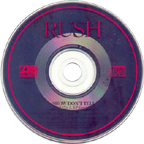
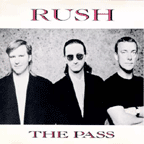
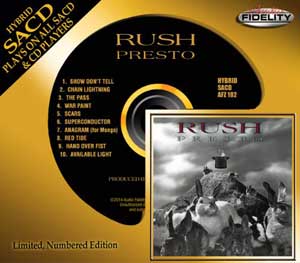
- Atlantic/Anthem, November 21, 1989
- Highest Billboard Chart Position: 16 - Certified Gold by RIAA: January 11, 1990
- There were two Presto promotional single edits released to support the album: "Show Don't Tell" (4:17 edit), and "The Pass" (4:21 edit).
- Reissued July 15, 2014 as a Audio Fidelity Sound Labs Gold SACD edition.
- Reissued October 23, 2015 by Universal Music Enterprises on 200-gram, heavyweight vinyl with a download code for a 320kbps MP4 vinyl ripped Digital Audio album as well as high resolution Digital Audio editions in DSD (2.8mHz), 192khz / 24-bit, 96kHz / 24-bit.
In Their Own Words
"The title 'Presto' was one that we came very close to using for the live album, and we decided on A Show Of Hands. It hung around, and we still liked it a lot, so it was suggested for this album. And at the same time, Neil was thinking up a song with the same title." - Geddy Lee, "Rockline", December 4, 1989
"Rupert [Hine] was somebody that we tried to work with a few years ago for the Grace Under Pressure album. And when Peter Collins was unavailable for this record, he was a first choice, a natural kind of choice to see if we could get our schedules together this time. Fortunately he was available and very interested and it all worked out." - Geddy Lee, "Rockline", December 4, 1989
"Rupert [Hine] is especially proud of his work with The Fixx, the British band who became prophets without honour in their own land, yet enjoyed huge success in the States with their Hine-enhanced attack. 'I came up with an entirely new guitar sound,' he asserts, marking the transition from the traditional 'big, heavy, dumpy, lumpy rock guitar sound' to something 'far more shiny but no less exciting'. It was a sound mimicked by countless acts. 'It had a huge appeal to rock bands,' he marvels. Rush, for example. 'Doing The Fixx led to Rush [1989's Presto and 1991's Roll The Bones] - they required constant sonic refreshment and they loved The Fixx. Neil Peart also loved the thinking behind my early 80s solo albums and thought that would be good for Rush.'" - Prog.teamrock.com, July 31, 2015
"We did plan on putting an instrumental song on this album, but in the process of putting it together, Neil kept on sending us all these lyrics...so we were saving all these bits for an instrumental song, and this one lyric came down the chute and it really suited what we had going for our instrumental track, so we decided, oh well, to hell with the instrumental, lets use the lyric, and that song turned into 'Hand Over Fist'." - Geddy Lee, "Rockline", December 4, 1989
"Some records I'm not terribly happy with the sound of: 'Presto' is a disappointing-sounding record. From a sonic point of view, it could sound a bit bigger." - Geddy Lee, Classic Rock, October 2004
"I wondered, 'what about Presto?' Our album from 1989 that for all of us should have been so much better than it was. That's the one that I know that if we could do one again, it would be that one, because we still love the songs from it, but you can never make magic happen. But I said 'we've got to do a song from that' so we brought back the song 'Presto' and we love playing it live. And it's so much better than the record." - Neil Peart with Jeff Woods, April 19, 2011
Regarding leaving Mercury Records for Atlantic
"Our contract with Phonogram expired and we decided it was time for a change. We were being thrown into the same category as our labelmates Bon Jovi and Def Leppard in terms of the way we were being marketed, yet they are mega-million selling bands in America, and inevitably Phonogram were concentrating on them. We needed a label that had the enthusiasm to push us; Atlantic have that quality." - Alex Lifeson, RAW No. 33, November 29, 1989
"We started to feel a little taken for granted. We are not a record company's dream. Atlantic, our new label, is convinced that they can do better for us. We're not saying, 'Sign us because we'll sell more records with you.' They're saying, 'Sign with us because we'll sell more records.' It's a pretty simple thing." - Neil Peart, Modern Drummer, December 1989
"We switched labels because we didn't have any feel for who was at our old company anymore and I kind of objected to being inherited and transferred from one president to another. We are NOT a typical band. We're regarded as difficult because we have low key life styles. We went to Atlantic because they are more music oriented. We just needed a fresh start." - Geddy Lee on leaving Mercury Records for Atlantic, Rock World, November 1993
Promos
Smartphone Wallpaper
Our RUSH smartphone wallpapers have been modified for a 9:19.5 aspect ratio to fit "most" Smartphones.
This is a collection of transcripts of magazine and newspaper articles and other media related to this release or coinciding with the time frame surrounding it. This is an ongoing work in progress; feel free to email any suggested additions.
